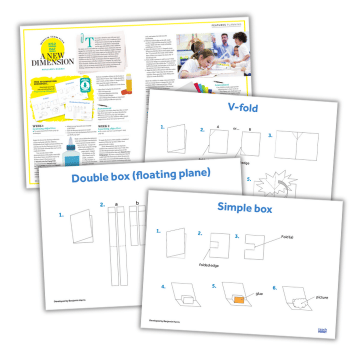PDF medium-term plan & visual instructions for pop-up construction
KS1, KS2
Years 2-6
This medium-term DT projects KS2 plan is ideal for use with any year group from Y2 to Y6. It explores three of the most common pop-up designs, and how to make them. These are:
- V-fold
- Simple box
- Double box (floating plane)
Depending on the age and ability of the children, the plan can be extended by creating a more elaborate pop-up design for each page. For example, some Year 6 children might combine different pop-ups on the same page, or you might glue the pop-ups together to create a book with a card cover.
All three of the designs are fairly straightforward to make, and introduce children to the two basic techniques that are apparent in all pop-up structures, whether simple or complex.
By exploring these models, children also learn some crucial technical paper skills, such as accurate measuring and cutting, and above all, folding, which is key for any pop-up to work effectively.
DT projects KS2 session 1
Begin the lesson by sharing a selection of pop-up books with the children. Emphasise how fragile and special they are, and discuss the fact that pop-ups are one of the few kinds of books that can’t yet be replicated online.
You can also share video demonstrations with pupils, especially if you don’t have any physical pop-up books to hand.
Next, get the children to explore the books and/or videos either by themselves or in small groups,
- Which is your favourite pop-up page of all? Why?
- How do the pop-ups seem to work?
- Can you see any mechanisms that move but are NOT pop-ups?
Make a clear distinction between pop-ups and paper mechanisms. A pop-up does exactly what it says on the tin – it pops out of the book using the energy drawn from pulling two pages apart.
A paper mechanism, on the other hand, may be a slide, a rotation, or a flap of paper. A pop-up book may have examples of both!
Now show your class samples of the V-fold and Box pop-ups they’ll be making in later lessons. Ask if they can find any examples of these in the books or videos they’ve seen. The V-folds should be easy to spot, as they make a V shape where they meet the pages of the book.
Finally, ask the children to write down:
- ideas they’ve had in the lesson for their own pop-ups
- annotated diagrams showing V-fold and Box shapes
- a list of things they think are important when making an effective pop-up
Ben Harris teaches Y6 and is English lead at Dunmow St Mary’s Primary in Essex. Browse more Year 6 DT projects or take a look at this mini canoe DT KS2 activity.














